I am creating a heat map using ggplot(), and would like to utilize the 3 color scheme of scale_fill_gradient2(). I've found, however that the middle color is too broad and tends to display some of my data negatively (using "black" for example). Is it possible to define the range that is considered "mid," to make it more narrow? If not, is there a better way that I may do so?
Data Set:
structure(list(var1 = structure(c(1L, 1L, 1L, 1L, 1L, 1L, 1L,
1L, 1L, 1L, 1L, 1L, 1L, 1L, 1L, 1L, 1L, 1L, 1L, 1L, 1L, 1L, 1L,
1L, 2L, 2L, 2L, 2L, 2L, 2L, 2L, 2L, 2L, 2L, 2L, 2L, 2L, 2L, 2L,
2L, 2L, 2L, 2L, 2L, 2L, 2L, 2L, 2L, 3L, 3L, 3L, 3L, 3L, 3L, 3L,
3L, 3L, 3L, 3L, 3L, 3L, 3L, 3L, 3L, 3L, 3L, 3L, 3L, 3L, 3L, 3L,
3L, 4L, 4L, 4L, 4L, 4L, 4L, 4L, 4L, 4L, 4L, 4L, 4L, 4L, 4L, 4L,
4L, 4L, 4L, 4L, 4L, 4L, 4L, 4L, 4L, 5L, 5L, 5L, 5L, 5L, 5L, 5L,
5L, 5L, 5L, 5L, 5L, 5L, 5L, 5L, 5L, 5L, 5L, 5L, 5L, 5L, 5L, 5L,
5L, 6L, 6L, 6L, 6L, 6L, 6L, 6L, 6L, 6L, 6L, 6L, 6L, 6L, 6L, 6L,
6L, 6L, 6L, 6L, 6L, 6L, 6L, 6L, 6L, 7L, 7L, 7L, 7L, 7L, 7L, 7L,
7L, 7L, 7L, 7L, 7L, 7L, 7L, 7L, 7L, 7L, 7L, 7L, 7L, 7L, 7L, 7L,
7L), .Label = c("A", "B", "C", "D", "E", "F", "G"), class = "factor"),
var2 = structure(c(1L, 2L, 3L, 4L, 5L, 6L, 7L, 8L, 9L, 10L,
11L, 12L, 13L, 14L, 15L, 16L, 17L, 18L, 19L, 20L, 21L, 22L,
23L, 24L, 1L, 2L, 3L, 4L, 5L, 6L, 7L, 8L, 9L, 10L, 11L, 12L,
13L, 14L, 15L, 16L, 17L, 18L, 19L, 20L, 21L, 22L, 23L, 24L,
1L, 2L, 3L, 4L, 5L, 6L, 7L, 8L, 9L, 10L, 11L, 12L, 13L, 14L,
15L, 16L, 17L, 18L, 19L, 20L, 21L, 22L, 23L, 24L, 1L, 2L,
3L, 4L, 5L, 6L, 7L, 8L, 9L, 10L, 11L, 12L, 13L, 14L, 15L,
16L, 17L, 18L, 19L, 20L, 21L, 22L, 23L, 24L, 1L, 2L, 3L,
4L, 5L, 6L, 7L, 8L, 9L, 10L, 11L, 12L, 13L, 14L, 15L, 16L,
17L, 18L, 19L, 20L, 21L, 22L, 23L, 24L, 1L, 2L, 3L, 4L, 5L,
6L, 7L, 8L, 9L, 10L, 11L, 12L, 13L, 14L, 15L, 16L, 17L, 18L,
19L, 20L, 21L, 22L, 23L, 24L, 1L, 2L, 3L, 4L, 5L, 6L, 7L,
8L, 9L, 10L, 11L, 12L, 13L, 14L, 15L, 16L, 17L, 18L, 19L,
20L, 21L, 22L, 23L, 24L), .Label = c("a", "b", "c", "d",
"e", "f", "g", "h", "i", "j", "k", "l", "m", "n", "o", "p",
"q", "r", "s", "t", "u", "v", "w", "x"), class = "factor"),
corr = c(0.039063517, -0.012531832, 0.096287532, -0.156156609,
-0.097044878, 0.144426494, 0.102142979, 0.061426893, 0.051079225,
0.271860908, 0.156812951, 0.259456277, -0.121838722, -0.157440078,
-0.037827967, -0.01929319, -0.108895665, -0.066815122, 0.254285337,
0.12688199, -0.064394035, 0.00112601, 0.173774179, 0.01179886,
0.105171013, 0.088559148, 0.033584364, -0.368075609, -0.272671354,
-0.456557935, -0.441008229, -0.118498286, -0.309056047, 0.051624421,
0.087594347, -0.0264506, 0.081249807, -0.194887615, -0.135397719,
-0.078688964, -0.059544125, -0.065410158, 0.211446055, 0.027338504,
-0.06185598, -0.007720807, 0.092997248, -0.177812491, 0.133226267,
0.075247459, 0.04586679, -0.37972917, -0.254410003, -0.447919321,
-0.426264017, -0.150347417, -0.270786314, 0.143483685, 0.230384468,
-0.012297462, 0.096957204, -0.134348613, -0.056239035, -0.038059581,
-0.040273741, -0.131126698, 0.222754865, 0.067883188, -0.154724805,
-0.076366467, 0.152747678, -0.160657826, 0.104652439, 0.029599007,
-0.02194356, -0.349623751, -0.228046427, -0.363148102, -0.326649794,
-0.160199177, -0.253621489, 0.242711785, 0.242808683, 0.005937022,
0.120849407, -0.131358491, 0.004558011, -0.056873299, 0.048745675,
-0.147360978, 0.204314713, 0.033110005, -0.154644375, -0.095999454,
0.202067265, -0.182694112, 0.071256125, 0.062783632, 0.078250678,
-0.348208521, -0.237899511, -0.235431913, -0.249280276, -0.129802124,
-0.084153729, 0.201859004, 0.292353092, -0.000270168, 0.130668616,
-0.101519227, -0.024695776, -0.024373331, -0.05976031, -0.07861482,
0.150316096, 0.100494694, -0.107507982, -0.06543542, 0.220813403,
-0.159374132, 0.139677124, 0.005974473, 0.011484774, -0.423918147,
-0.286712875, -0.286979217, -0.2730134, -0.095014441, -0.134216671,
0.215551068, 0.432571228, 0.029945066, 0.178996421, -0.114005412,
-0.098205883, 0.009661061, -0.07163473, 0.010722592, 0.175801779,
0.170582102, -0.199407024, -0.15933157, 0.246575881, -0.084929336,
0.160642274, 0.025941888, -0.058676465, -0.297996589, -0.180504241,
-0.236672516, -0.228203539, -0.181349045, -0.091893083, 0.277145017,
0.38119709, 0.019554381, 0.18725277, -0.019416086, 0.000417258,
0.134560252, 0.059330986, -0.091994882, 0.11807573, 0.175219716,
-0.169272253, -0.094240107, 0.180532375, 0.04322002)), .Names = c("var1", "var2", "corr"), class = "data.frame", row.names = c(NA, -168L))
Code using reshape2, ggplot2, and scales:
sample.m <- melt(sample)
sample.m$var2 <- as.character(sample.m$var2)
sample.m$var2 <- factor(sample.m$var2, levels=unique(sample.m$var2),ordered=TRUE)
sample.m$var1 <- as.character(sample.m$var1)
sample.m$var1 <- factor(sample.m$var1, levels=unique(sample.m$var1),ordered=TRUE)
p <- ggplot(sample.m, aes(var2,var1)) + geom_tile(aes(fill=value), colour="transparent") + scale_fill_gradient2(low="cyan", mid="black", high="red", midpoint=0, limits=c(-0.6,0.6))
base_size <- 9
p + theme_bw() + labs(x = "", y = "") + scale_x_discrete(expand = c(0,0)) + theme(legend.position = "bottom", axis.ticks = element_blank(), axis.text.x = element_text(size = base_size * 0.8, angle = 310, hjust = 0, colour = "black"), axis.text.y = element_text(size = base_size * 0.8,colour = "black"))


